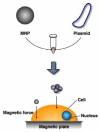Application of magnetic nanoparticles to gene delivery
- PMID: 21747701
- PMCID: PMC3131585
- DOI: 10.3390/ijms12063705
Application of magnetic nanoparticles to gene delivery
Abstract
Nanoparticle technology is being incorporated into many areas of molecular science and biomedicine. Because nanoparticles are small enough to enter almost all areas of the body, including the circulatory system and cells, they have been and continue to be exploited for basic biomedical research as well as clinical diagnostic and therapeutic applications. For example, nanoparticles hold great promise for enabling gene therapy to reach its full potential by facilitating targeted delivery of DNA into tissues and cells. Substantial progress has been made in binding DNA to nanoparticles and controlling the behavior of these complexes. In this article, we review research on binding DNAs to nanoparticles as well as our latest study on non-viral gene delivery using polyethylenimine-coated magnetic nanoparticles.
Keywords: Magnetofection; gene delivery; magnetic nanoparticles; polyethylenimine.
Figures





Similar articles
-
Dendrimer modified magnetic iron oxide nanoparticle/DNA/PEI ternary complexes: a novel strategy for magnetofection.J Control Release. 2011 Nov 30;152 Suppl 1:e159-60. doi: 10.1016/j.jconrel.2011.08.061. J Control Release. 2011. PMID: 22195820 No abstract available.
-
Multifunctional magnetic nanoparticles modified with polyethylenimine and folic acid for biomedical theranostics.Langmuir. 2013 May 21;29(20):5962-7. doi: 10.1021/la3051302. Epub 2013 May 7. Langmuir. 2013. PMID: 23650947
-
Superparamagnetic iron oxide nanoparticles modified with polyethylenimine and galactose for siRNA targeted delivery in hepatocellular carcinoma therapy.Int J Nanomedicine. 2018 Mar 26;13:1851-1865. doi: 10.2147/IJN.S155537. eCollection 2018. Int J Nanomedicine. 2018. PMID: 29618926 Free PMC article.
-
Magnetite-based Janus nanoparticles, their synthesis and biomedical applications.Wiley Interdiscip Rev Nanomed Nanobiotechnol. 2023 Nov-Dec;15(6):e1908. doi: 10.1002/wnan.1908. Epub 2023 Jun 4. Wiley Interdiscip Rev Nanomed Nanobiotechnol. 2023. PMID: 37271573 Review.
-
A Detailed Review on Synthesis, Functionalization, Application, Challenges, and Current Status of Magnetic Nanoparticles in the Field of Drug Delivery and Gene Delivery System.AAPS PharmSciTech. 2022 Dec 22;24(1):25. doi: 10.1208/s12249-022-02485-5. AAPS PharmSciTech. 2022. PMID: 36550283 Review.
Cited by
-
Nonviral Locally Injected Magnetic Vectors for In Vivo Gene Delivery: A Review of Studies on Magnetofection.Nanomaterials (Basel). 2021 Apr 22;11(5):1078. doi: 10.3390/nano11051078. Nanomaterials (Basel). 2021. PMID: 33922066 Free PMC article. Review.
-
Modified Fe3O4 Magnetic Nanoparticle Delivery of CpG Inhibits Tumor Growth and Spontaneous Pulmonary Metastases to Enhance Immunotherapy.Nanoscale Res Lett. 2018 Aug 17;13(1):240. doi: 10.1186/s11671-018-2661-8. Nanoscale Res Lett. 2018. PMID: 30120629 Free PMC article.
-
Pushing of Magnetic Microdroplet Using Electromagnetic Actuation System.Nanomaterials (Basel). 2020 Feb 20;10(2):371. doi: 10.3390/nano10020371. Nanomaterials (Basel). 2020. PMID: 32093280 Free PMC article.
-
Biodistribution and toxicity of epitope-functionalized dextran iron oxide nanoparticles in a pregnant murine model.J Biomed Mater Res A. 2020 May;108(5):1186-1202. doi: 10.1002/jbm.a.36893. Epub 2020 Feb 26. J Biomed Mater Res A. 2020. PMID: 32031743 Free PMC article.
-
Engineered Protein-Driven Synthesis of Tunable Iron Oxide Nanoparticles as T1 and T2 Magnetic Resonance Imaging Contrast Agents.Chem Mater. 2022 Dec 27;34(24):10832-10841. doi: 10.1021/acs.chemmater.2c01746. Epub 2022 Dec 2. Chem Mater. 2022. PMID: 36590706 Free PMC article.
References
-
- Chouly C, Pouliquen D, Lucet I, Jeune JJ, Jallet P. Development of superparamagnetic nanoparticles for MRI: Effect of particle size, charge and surface nature on biodistribution. J. Microencapsul. 1996;13:245–255. - PubMed
-
- Yoo B, Pagel MD. An overview of responsive MRI contrast agents for molecular imaging. Front. Biosci. 2008;13:1733–1752. - PubMed
Publication types
MeSH terms
Substances
LinkOut - more resources
Full Text Sources
Other Literature Sources

